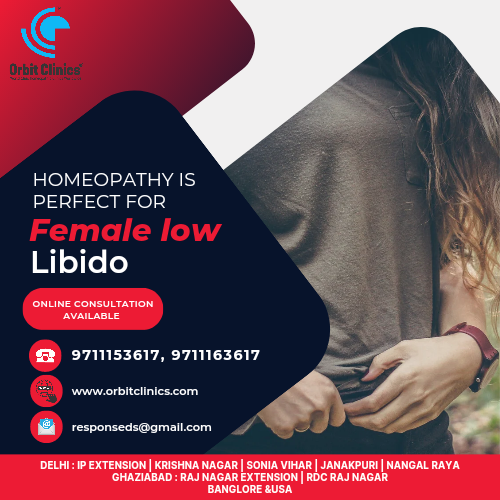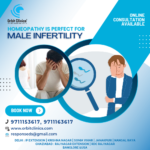“A Comprehensive Exploration of Causes, Treatments, and Future Directions”

Written by
Dr. Deepak Sharma
BHMS, MD, Ph.D. (Scholar)
Homeopathic Physician and Educator
Founder – Orbit Clinics
Abstract:
Low libido, or reduced sexual desire, is a widespread concern for many women. Despite its high prevalence, the complexity and multifaceted nature of female sexual desire makes it a challenging subject to address. This article aims to provide an in-depth analysis of the factors contributing to low libido in females, exploring the intricate interplay between biological, psychological, and sociocultural elements. Additionally, we will review the current strategies and treatments available to tackle this issue and suggest future directions for research and clinical interventions.
Introduction:
Female sexual desire is a complex and multifaceted phenomenon, influenced by a myriad of factors that range from biological and psychological to socio-cultural. Low libido, or hypoactive sexual desire disorder (HSDD), is a prevalent issue among women, with approximately 30-50% experiencing it at some point in their lives. Despite this, low libido remains underdiagnosed and undertreated due to a combination of factors, including stigma, limited understanding, and inadequate research.
Biological factors:
- Hormonal imbalances: Hormones play a crucial role in regulating female sexual desire. Estrogen, progesterone, and testosterone are particularly influential. Imbalances in these hormones, such as those occurring during menopause or as a result of polycystic ovary syndrome (PCOS), can contribute to low libido. Additionally, hormonal contraceptives may also affect sexual desire in some women.
- Medical conditions: Chronic illnesses, such as diabetes, hypertension, and thyroid disorders, can negatively impact sexual desire. Moreover, certain medications, such as antidepressants and antihypertensives, may also contribute to reduced libido.
Psychological factors:
- Mental health: Mental health issues, such as depression, anxiety, and stress, can have a significant impact on sexual desire. Furthermore, unresolved trauma, particularly related to sexual experiences like rape, can contribute to low libido.
- Relationship dynamics: Interpersonal factors, including poor communication, unresolved conflicts, or lack of emotional intimacy, can influence sexual desire within a relationship.
Sociocultural factors:
- Cultural and religious beliefs: Cultural and religious norms surrounding sexuality may inhibit sexual desire, leading to feelings of guilt or shame associated with sexual expression.
- Societal expectations: Societal expectations regarding gender roles, body image, and sexuality can impact an individual’s perception of their sexual self and contribute to low libido.
Psychological Impact of Low Libido on females:
While it is important to note that individual experiences vary, common psychological effects of low libido in females include:
- Lower self-esteem: Women with low libido may feel less confident or attractive, which can lead to a negative self-image and decreased self-esteem.
- Relationship stress: A decreased interest in sex can cause tension and conflict in romantic relationships, as partners may feel rejected or unfulfilled. This can create emotional distance and strain, potentially jeopardizing the overall stability of the relationship.
- Anxiety and guilt: Women experiencing low libido may feel anxious about their lack of desire, and this anxiety can further exacerbate the issue. They may also feel guilt over not being able to meet their partner’s sexual needs, which can compound the stress they are experiencing.
- Depression: The frustration and stress caused by low libido can contribute to feelings of sadness, hopelessness, and even depression, especially if the issue is persistent and unresolved.
- Isolation: Women with low libido may isolate themselves from their partner or friends, feeling embarrassed or ashamed of their lack of sexual desire.
- Identity struggles: Sexuality is an important aspect of personal identity, and women with low libido may struggle with understanding their own sexual identity or feeling disconnected from it.
Future directions:
- Personalized medicine: Future research should focus on the development of tailored interventions that consider the unique combination of factors contributing to low libido in individual women.
- Improved education and awareness: Enhancing public and professional understanding of female sexual desire and its complexities is essential for reducing stigma and improving access to appropriate care.
Current strategies and treatments:
- Hormonal therapies: Hormone replacement therapy (HRT) and testosterone supplementation have shown promise in addressing hormone-related low libido. However, further research is needed to establish the long-term safety and efficacy of these treatments.
- Psychological interventions: Cognitive-behavioral therapy (CBT) and sex therapy can help address psychological factors contributing to low libido by improving communication, challenging unhelpful beliefs, and fostering a positive sexual self-concept. Counseling for females experiencing low libido is one of the most common ways to address the issue and improve overall well-being. It’s important to remember that everyone’s situation is unique, and there is no one-size-fits-all solution.
- Lifestyle modifications: Adopting a healthy lifestyle, including regular exercise, a balanced diet, and stress management, can improve overall well-being and positively impact sexual desire.
- Homeopathy: Some common homeopathic remedies that are often used to address low libido in women include:
- Sepia: This remedy is often used for women who experience a lack of sexual desire or have feelings of indifference towards sex. Sepia is derived from the ink of the cuttlefish and is believed to help balance hormones and improve overall sexual health.
- Lycopodium: Derived from the spores of a club moss plant, Lycopodium is thought to help with low libido associated with anxiety, lack of confidence, or digestive issues.
- Argentum Nitricum: This remedy, made from silver nitrate, is often recommended for women experiencing anxiety and nervousness around sex or those who have a fear of failure in sexual situations.
- Natrum Muriaticum: Derived from sodium chloride (table salt), Natrum Muriaticum is believed to help with low libido caused by emotional stress, grief, or past traumas.
- Agnus Castus: Also known as the chaste tree or chasteberry, Agnus Castus is a plant-based remedy that is thought to help balance hormones and improve sexual desire in women experiencing low libido due to hormonal imbalances.
References:
- Basson, R. (2006). Women’s sexual function and dysfunction: current uncertainties, future directions. International Journal of Impotence Research, 18(5), 427-432.
- Brotto, L. A., Atallah, S., Johnson-Agbakwu, C., Rosenbaum, T., Abdo, C., Byers, E. S., … & Wylie, K. (2016). Psychological and interpersonal dimensions of sexual function and dysfunction. Journal of Sexual Medicine, 13(4), 538-571.
- Clayton, A. H., & Hamilton, D. V. (2010). Female sexual dysfunction. Psychiatric Clinics of North America, 33(2), 323-338.
- Davis, S. R., & Worsley, R. (2014). Androgen treatment of postmenopausal women. Journal of Steroid Biochemistry and Molecular Biology, 142, 107-114.
- Goldstein, I., Kim, N. N., Clayton, A. H., DeRogatis, L. R., Giraldi, A., Parish, S. J., … & Simon, J. A. (2017). Hypoactive sexual desire disorder: International Society for the Study of Women’s Sexual Health (ISSWSH) expert consensus panel review. Mayo Clinic Proceedings, 92(1), 114-128.
- Kingsberg, S. A., & Woodard, T. (2015). Female sexual dysfunction: focus on low desire. Obstetrics and Gynecology, 125(2), 477-486.
- Leiblum, S. R., Koochaki, P. E., Rodenberg, C. A., Barton, I. P., & Rosen, R. C. (2006). Hypoactive sexual desire disorder in postmenopausal women: US results from the Women’s International Study of Health and Sexuality (WISHeS). Menopause, 13(1), 46-56.
- Shifren, J. L., Monz, B. U., Russo, P. A., Segreti, A., & Johannes, C. B. (2008). Sexual problems and distress in United States women: prevalence and correlates. Obstetrics and Gynecology, 112(5), 970-978.
- Upton, G., & Dwyer, M. (2014). The impact of relationship factors on sexual dysfunction in men and women. Current Sexual Health Reports, 6(3), 144-149.
- Vickers, A. J., & Smith, C. (2004). Homeopathic Oscillococcinum for preventing and treating influenza and influenza-like syndromes. Cochrane Database of Systematic Reviews, 2004(1), CD001957.
- Wylie, K., Rees, M., Hackett, G., Anderson, R., Bouloux, P. M., Cust, M., … & Kingsberg, S. (2010). Androgens, health, and sexuality in women and men. Human Reproduction Update, 16(6), 639-652.
Written by
Dr. Deepak Sharma
BHMS, MD, Ph.D. (Scholar)
Homeopathic Physician and Educator
Founder – Orbit Clinics




